Recent Progress in Gd-Containing Materials for Neutron Shielding Applications: A Review
Abstract
1. Introduction
2. Gd-Containing Inorganic Nonmetallic Neutron Shielding Materials
2.1. Concrete-Based Neutron Shielding Materials
2.2. Glass-Based Neutron Shielding Materials
2.3. Ceramic-Based Neutron Shielding Materials
3. Gd-Containing Polymeric Neutron Shielding Materials
3.1. Traditional Polymer-Based Shielding Neutron Materials
3.2. Novel Polymer-Based Shielding Neutron Materials
3.3. Improving Neutron Shielding and Mechanical Properties of PMCs with Gd Nanofillers
4. Gd-Containing Metallic Neutron Shielding Materials
4.1. Fe-Based Alloys/Composites
4.2. Al-Based Alloys/Composites
4.3. Other Metal-Based Alloys
5. Summary
- There is a mutually restrictive relationship between neutron shielding performance and the mechanical properties of Gd-containing shielding materials. Increasing the Gd content has the potential to improve the thermal neutron absorbing abilities of shielding materials, but excessive Gd content may lead to a reduction in mechanical properties (e.g., plasticity and strength). Furthermore, the high quantities of Gd may complicate the manufacture of shielding materials, e.g., the powder metallurgy method plus the deformation technique for metal-based materials. Therefore, the manipulations of the preparation procedures, neutron shielding performance, and mechanical properties are tough but critical. Possibly, a potential research direction is to establish theoretical models capable of determining the appropriate Gd addition for the controllable fabrication process, thus obtaining a trade-off between neutron shielding performance and mechanical properties.
- Although Gd possesses a high thermal neutron absorbing ability, its shielding efficiency against fast neutrons is negligible. Moreover, the absorption of neutrons by Gd is accompanied by the release of secondary γ-rays, thereby posing a potential radiation hazard. In other words, both neutron and γ-ray radiation may occur simultaneously in practical applications. Therefore, shielding materials must have effective neutron shielding abilities for both fast and thermal neutrons, as well as adequate γ-ray radiation shielding performance. H-rich materials (e.g., polymers) and concretes are considered to be the optimal choice for attenuating fast neutrons. Thus, they can be used as the matrix to improve the overall neutron shielding performance of Gd-containing shielding material. For the deficiency of Gd-containing materials in shielding γ-ray radiation, incorporating components with high γ-ray radiation shielding properties (e.g., W, concrete, steel) is feasible. For instance, the Gd2O3@W core–shell structure with a W outer layer has proven to be promising for both neutron and γ-ray radiation shielding.
- It is still challenging to improve the neutron shielding performance of Gd-containing materials. In this regard, regulating the form of Gd in the matrix and ensuring a homogenous distribution of Gd components is critical in the fabrication of Gd-containing shielding materials. Specifically, it is important to modify the preparation process of shielding materials to improve the homogeneity of the distribution of Gd-containing phases, promote the generation of reinforcing phases that are beneficial to the material properties, and avoid the appearance of harmful secondary phases. In addition, there are some innovative material preparation technologies, e.g., additive manufacturing, that allow for the fabrication of custom-designed samples with more freedom. This novel material processing method may give more options for meeting the demands of practical applications.
Author Contributions
Funding
Institutional Review Board Statement
Informed Consent Statement
Data Availability Statement
Conflicts of Interest
References
- I.A.E. Agency. IAEA Annual Report 2021; I.A.E. Agency: Vienna, Austria, 2021. [Google Scholar]
- Ewing, R.C. Long-term storage of spent nuclear fuel. Nat. Mater. 2015, 14, 252–257. [Google Scholar] [CrossRef]
- Ewing, R.C.; Weber, W.J.; Clinard, F.W., Jr. Radiation effects in nuclear waste forms for high-level radioactive waste. Prog. Nucl. Energy 1995, 29, 63–127. [Google Scholar] [CrossRef]
- Amaldi, E.; Fano, U.; Spencer, L.V.; Berger, M.J. Neutrons and Related Gamma Ray Problems; Springer: Berlin/Heidelberg, Germany, 2012. [Google Scholar]
- Tyagi, G.; Singhal, A.; Routroy, S.; Bhunia, D.; Lahoti, M. Radiation Shielding Concrete with alternate constituents: An approach to address multiple hazards. J. Hazard. Mater. 2021, 404 Pt B, 124201. [Google Scholar] [CrossRef]
- Suzuki, K.; Yamazaki, S.; Iwata, K.-I.; Yamada, Y.; Morioka, T.; Daino, K.; Kaminishi, M.; Ogawa, M.; Shimada, Y.; Kakinuma, S. Lung-Cancer Risk in Mice after Exposure to Gamma Rays, Carbon Ions or Neutrons: Egfr Pathway Activation and Frequent Nuclear Abnormality. Radiat. Res. 2022, 198, 475–487. [Google Scholar] [CrossRef]
- Burgio, E.; Piscitelli, P.; Migliore, L. Ionizing Radiation and Human Health: Reviewing Models of Exposure and Mechanisms of Cellular Damage. An Epigenetic Perspective. Int. J. Environ. Res. Public Health 2018, 15, 1971. [Google Scholar] [CrossRef]
- Koo, Y.-H.; Yang, Y.-S.; Song, K.-W. Radioactivity release from the Fukushima accident and its consequences: A review. Prog. Nucl. Energy 2014, 74, 61–70. [Google Scholar] [CrossRef]
- Wood, J. Chapter 6—Neutron Attenuation. In Computational Methods in Reactor Shielding; Wood, J., Ed.; International Atomic Energy Agency: Pergamon, Turkey, 1982; pp. 192–269. [Google Scholar]
- Gibson, J.A.B.; Piesch, E.; Agency, I.A.E. Neutron Monitoring for Radiological Protection: A Manual; International Atomic Energy Agency: Pergamon, Turkey, 1985. [Google Scholar]
- Jing, H.; Geng, L.; Qiu, S.; Zou, H.; Liang, M.; Deng, D. Research progress of rare earth composite shielding materials. J. Rare Earth 2023, 41, 32–41. [Google Scholar] [CrossRef]
- Shusterman, J.A.; Scielzo, N.D.; Thomas, K.J.; Norman, E.B.; Lapi, S.E.; Loveless, C.S.; Peters, N.J.; Robertson, J.D.; Shaughnessy, D.A.; Tonchev, A.P. The surprisingly large neutron capture cross-section of Zr-88. Nature 2019, 565, 328. [Google Scholar] [CrossRef] [PubMed]
- Machiels, A.; Lambert, R. Handbook of Neutron Absorber Materials for Spent Nuclear Fuel Transportation and Storage Applications; Electric Power Research Institute, Inc.: Palo Alto, CA, USA, 2009; pp. 101–110. [Google Scholar]
- Robards, K.; Worsfold, P. Cadmium: Toxicology and analysis. A review. Analyst 1991, 116, 549–568. [Google Scholar] [CrossRef]
- Florez, R.; Colorado, H.A.; Giraldo, C.H.C.; Alajo, A. Preparation and characterization of Portland cement pastes with Sm2O3 microparticle additions for neutron shielding applications. Constr. Build. Mater. 2018, 191, 498–506. [Google Scholar] [CrossRef]
- Cuer, P.; Lattes, C.M.G. Radioactivity of Samarium. Nature 1946, 158, 197–198. [Google Scholar] [CrossRef] [PubMed]
- Barth, R.F.; Mi, P.; Yang, W. Boron delivery agents for neutron capture therapy of cancer. Cancer Commun. 2018, 38, 35. [Google Scholar] [CrossRef] [PubMed]
- Jung, Y.-J.; Hwang, J.; Yeon, J.-W.; Boo, B.H.; Song, K. Dispersion properties of B4C microparticles as emergency neutron absorbers in Spent-Fuel pool water. Nucl. Sci. Eng. 2012, 172, 202–207. [Google Scholar] [CrossRef]
- Basturk, M.; Arztmann, J.; Jerlich, W.; Kardjilov, N.; Lehmann, E.; Zawisky, M. Analysis of neutron attenuation in boron-alloyed stainless steel with neutron radiography and JEN-3 gauge. J. Nucl. Mater. 2005, 341, 189–200. [Google Scholar] [CrossRef]
- Usta, M.; Tozar, A. The effect of the ceramic amount on the radiation shielding properties of metal-matrix composite coatings. Radiat. Phys. Chem. 2020, 177, 109086. [Google Scholar] [CrossRef]
- Li, Y.; Wang, W.; Zhou, J.; Chen, H.; Zhang, P. 10B areal density: A novel approach for design and fabrication of B4C/6061Al neutron absorbing materials. J. Nucl. Mater. 2017, 487, 238–246. [Google Scholar] [CrossRef]
- Abenojar, J.; Martinez, M.A.; Velasco, F. Effect of the boron content in the aluminium/boron composite. J. Alloys Compd. 2006, 422, 67–72. [Google Scholar] [CrossRef]
- Zhang, F.; Wang, X.; Wierschke, J.B.; Wang, L. Helium bubble evolution in ion irradiated Al/B4C metal metrix composite. Scr. Mater. 2015, 109, 28–33. [Google Scholar] [CrossRef]
- Dunning, J.R.; Pegram, G.B.; Fink, G.A.; Mitchell, D.P. Interaction of Neutrons with Matter. Phys. Rev. 1935, 48, 265–280. [Google Scholar] [CrossRef]
- Lapp, R.E.; VanHorn, J.R.; Dempster, A.J. The neutron absorbing isotopes in gadolinium and samarium. Phys. Rev. 1947, 71, 745–747. [Google Scholar] [CrossRef]
- Leinweber, G.; Barry, D.P.; Trbovich, M.J.; Burke, J.A.; Drindak, N.J.; Knox, H.D.; Ballad, R.V.; Block, R.C.; Danon, Y.; Severnyak, L.I. Neutron capture and total cross-section measurements and resonance parameters of gadolinium. Nucl. Sci. Eng. 2006, 154, 261–279. [Google Scholar] [CrossRef]
- Burke, D.S.; Byun, S.H. Feasibility of gadolinium oxide paint as neutron shielding. Nucl. Instrum. Methods Phys. Res. Sect. A Accel. Spectrometers Detect. Assoc. Equip. 2022, 1025, 166–175. [Google Scholar] [CrossRef]
- Kandlakunta, P.; Cao, L.R.; Mulligan, P. Measurement of internal conversion electrons from Gd neutron capture. Nucl. Instrum. Methods Phys. Res. Sect. A Accel. Spectrometers, Detect. Assoc. Equip. 2013, 705, 36–41. [Google Scholar] [CrossRef]
- Bashter, I.I. Calculation of radiation attenuation coefficients for shielding concretes. Ann. Nucl. Energy 1997, 24, 1389–1401. [Google Scholar] [CrossRef]
- Oto, B.; Gür, A.; Kavaz, E.; Çakır, T.; Yaltay, N. Determination of gamma and fast neutron shielding parameters of magnetite concretes. Prog. Nucl. Energy 2016, 92, 71–80. [Google Scholar] [CrossRef]
- Kharita, M.H.; Yousef, S.; AlNassar, M. The effect of the initial water to cement ratio on shielding properties of ordinary concrete. Prog. Nucl. Energy 2010, 52, 491–493. [Google Scholar] [CrossRef]
- Thomas, C.; Rico, J.; Tamayo, P.; Setién, J.; Ballester, F.; Polanco, J.A. Neutron shielding concrete incorporating B4C and PVA fibers exposed to high temperatures. J. Build. Eng. 2019, 26, 100859. [Google Scholar] [CrossRef]
- Park, J.S.; Kim, J.; Yi, S.H. Effects of Gadolinium in Fe based amorphous ribbons with high boron contents on the neutron shielding efficiency. Ann. Nucl. Energy 2017, 109, 365–369. [Google Scholar] [CrossRef]
- Seshadri, B.S. Transmission measurements of D-T neutrons through gadolinium loaded concrete and polypropylene. J. Nucl. Sci. Technol. 1989, 26, 881–886. [Google Scholar] [CrossRef]
- Piotrowski, T.; Tefelski, D.B.; Sokołowska, J.J.; Jaworska, B. NGS-concrete-new generation shielding concrete against ionizing radiation-the potential evaluation and preliminary investigation. Acta Phys. Pol. A 2015, 128, 9–13. [Google Scholar] [CrossRef]
- Zalegowski, K.; Piotrowski, T.; Garbacz, A.; Adamczewski, G. Relation between microstructure, technical properties and neutron radiation shielding efficiency of concrete. Constr. Build. Mater. 2020, 235, 117389. [Google Scholar] [CrossRef]
- Piotrowski, T.; Glinicka, J.; Glinicki, M.A.; Prochoń, P. Influence of gadolinium oxide and ulexite on cement hydration and technical properties of mortars for neutron radiation shielding purposes. Constr. Build. Mater. 2019, 195, 583–589. [Google Scholar] [CrossRef]
- Katagiri, M.; Sakasai, K.; Matsubayashi, M.; Kojima, T. Neutron/gamma-ray discrimination characteristics of novel neutron scintillators. Nucl. Instrum. Methods Phys. Res. Sect. A Accel. Spectrometers Detect. Assoc. Equip. 2004, 529, 317–320. [Google Scholar] [CrossRef]
- Tekin, H.O.; Altunsoy, E.E.; Kavaz, E.; Sayyed, M.I.; Agar, O.; Kamislioglu, M. Photon and neutron shielding performance of boron phosphate glasses for diagnostic radiology facilities. Results Phys. 2019, 12, 1457–1464. [Google Scholar] [CrossRef]
- Kaewjang, S.; Maghanemi, U.; Kothan, S.; Kim, H.J.; Limkitjaroenporn, P.; Kaewkhao, J. New gadolinium based glasses for gamma-rays shielding materials. Nucl. Eng. Des. 2014, 280, 21–26. [Google Scholar] [CrossRef]
- Ruengsri, S.; Kaewkhao, J.; Limkitjaroenporm, P.; Meejitpaisan, P.; Hongtong, W.; Cheewasukhanont, W. Development of gadolinium calcium phosphate oxyfluoride glass for radiation shielding materials. Integr. Ferroelectr. 2017, 177, 48–58. [Google Scholar] [CrossRef]
- Singh, V.P.; Badiger, N.M.; Kothan, S.; Kaewjaeng, S.; Korkut, T.; Kim, H.J.; Kaewkhao, J. Gamma-ray and neutron shielding efficiency of Pb-free gadolinium-based glasses. Nucl. Sci. Tech. 2016, 27, 103. [Google Scholar] [CrossRef]
- Mahmoud, K.A.; El-Agwany, F.I.; Rammah, Y.S.; Tashlykov, O.L. Gamma ray shielding capacity and build up factors of CdO doped lithium borate glasses: Theoretical and simulation study. J. Non. Cryst. Solids 2020, 541, 120110. [Google Scholar] [CrossRef]
- Al-Buriahi, M.S.; Tonguç, B.; Perişanoğlu, U.; Kavaz, E. The impact of Gd2O3 on nuclear safety proficiencies of TeO2–ZnO–Nb2O5 glasses: A GEANT4 Monte Carlo study. Ceram. Int. 2020, 46, 23347–23356. [Google Scholar] [CrossRef]
- Al-Hadeethi, Y.; Sayyed, M.I.; Agar, O. Ionizing photons attenuation characterization of quaternary tellurite–zinc–niobium–gadolinium glasses using Phy-X/PSD software. J. Non. Cryst. Solids 2020, 538, 120044. [Google Scholar] [CrossRef]
- Ibrahim, S.; El-Agawany, F.I.; Rammah, Y.S.; Ahmed, E.M.; Ali, A.A. ZnO-Bi2O3-B2O3 glasses doped with rare earth oxides: Synthesis, physical, structural characteristics, neutron and photon attenuation attitude. Optik 2021, 243, 167414. [Google Scholar] [CrossRef]
- Lakshminarayana, G.; Tekin, H.O.; Dong, M.G.; Al-Buriahi, M.S.; Lee, D.E.; Yoon, J.; Park, T. Comparative assessment of fast and thermal neutrons and gamma radiation protection qualities combined with mechanical factors of different borate-based glass systems. Results Phys. 2022, 37, 105527. [Google Scholar] [CrossRef]
- El-Khayatt, A.M.; Saudi, H.A. Recycling of waste porcelain into newly developed bismo-borate glass admixture with Gd3+ ions for nuclear radiation protection uses: An experimental and theoretical study. Radiat. Phys. Chem. 2023, 203, 110612. [Google Scholar] [CrossRef]
- Al-Hadeethi, Y.; Sayyed, M.I.; Kaewkhao, J.; Raffah, B.M.; Almalki, R.; Rajaramakrishna, R. An extensive investigation of physical, optical and radiation shielding properties for borate glasses modified with gadolinium oxide. Appl. Phys. A 2019, 125, 749. [Google Scholar] [CrossRef]
- Intachai, N.; Wantana, N.; Kaewjaeng, S.; Chaiphaksa, W.; Cheewasukhanont, W.; Htun, K.T.; Kothan, S.; Kim, H.J.; Kaewkhao, J. Effect of Gd2O3 on radiation shielding, physical and optical properties of sodium borosilicate glass system. Radiat. Phys. Chem. 2022, 199, 110361. [Google Scholar] [CrossRef]
- Shamshad, L.; Rooh, G.; Limkitjaroenporn, P.; Srisittipokakun, N.; Chaiphaksa, W.; Kim, H.J.; Kaewkhao, J. A comparative study of gadolinium based oxide and oxyfluoride glasses as low energy radiation shielding materials. Prog. Nucl. Energy 2017, 97, 53–59. [Google Scholar] [CrossRef]
- Barsoum, M. Fundamentals of Ceramics. In Fundamentals of Ceramics; CRC Press: Boca Raton, FL, USA, 2003; pp. 441–464. [Google Scholar]
- Akman, F.; Khattari, Z.Y.; Kaçal, M.R.; Sayyed, M.I.; Afaneh, F. The radiation shielding features for some silicide, boride and oxide types ceramics. Radiat. Phys. Chem. 2019, 160, 9–14. [Google Scholar] [CrossRef]
- Ge, R.; Zhang, Y.; Liu, Y.; Fang, J.; Luan, W.; Wu, G. Effect of Gd2O3 addition on mechanical, thermal and shielding properties of Al2O3 ceramics. J. Mater. Sci. Mater. Electron. 2016, 28, 5898–5905. [Google Scholar] [CrossRef]
- Hernández, M.F.; Herrera, M.S.; Anaya, R.; Martinez, J.M.; Cipollone, M.; Conconi, M.S.; Rendtorff, N.M. High macroscopic neutron capture cross section ceramics based on bauxite and Gd2O3. Sci. Sinter. 2020, 52, 387–403. [Google Scholar] [CrossRef]
- Mhareb, M.H.A.; Slimani, Y.; Alajerami, Y.S.; Sayyed, M.I.; Lacomme, E.; Almessiere, M.A. Structural and radiation shielding properties of BaTiO3 ceramic with different concentrations of Bismuth and Ytterbium. Ceram. Int. 2020, 46, 28877–28886. [Google Scholar] [CrossRef]
- Dong, C.; Li, Y.; Li, S.; Jia, W.; Chen, R.; Lao, D.; Xia, X. Thermally insulating GdBO3 ceramics with neutron shielding performance. Int. J. Appl. Ceram. Technol. 2022, 19, 1428–1438. [Google Scholar] [CrossRef]
- Li, Y.; Luo, H.; He, Z.; Xiang, R.; Jia, W.; Li, S.; Lao, D.; Zhou, Z.; Dong, C. Structural stability and neutron-shielding capacity of GdBO3-Al18B4O33 composite ceramics: Experimental investigation and numerical simulation. Ceram. Int. 2021, 47, 20935–20947. [Google Scholar] [CrossRef]
- Akrami, S.; Edalati, P.; Fuji, M.; Edalati, K. High-entropy ceramics: Review of principles, production and applications. Mater. Sci. Eng. R Rep. 2021, 146, 100644. [Google Scholar] [CrossRef]
- Zhang, X.; Li, Y.; Li, C.; Yang, F.; Jiang, Z.; Xue, L.; Shao, Z.; Zhao, Z.; Xie, M.; Yu, S. A novel (La0.2Ce0.2Gd0.2Er0.2Tm0.2)2(WO4)3 high-entropy ceramic material for thermal neutron and gamma-ray shielding. Mater. Des. 2021, 205, 109722. [Google Scholar] [CrossRef]
- Wang, G.; Zhang, J.; Shen, S.; Zhong, L.; Mei, L.; Tang, Z. 3D printing of gadolinium oxide structure neutron absorber. Ceram. Int. 2022, 48, 35198–35208. [Google Scholar] [CrossRef]
- Hayashi, T.; Tobita, K.; Nakamori, Y.; Orimo, S. Advanced neutron shielding material using zirconium borohydride and zirconium hydride. J. Nucl. Mater. 2009, 386–388, 119–121. [Google Scholar] [CrossRef]
- Abuali Galehdari, N.; Kelkar, A.D. Effect of neutron radiation on the mechanical and thermophysical properties of nanoengineered polymer composites. J. Mater. Res. 2017, 32, 426–434. [Google Scholar] [CrossRef]
- Prabhu, S.; Bubbly, S.G.; Gudennavar, S.B. X-Ray and γ-Ray Shielding Efficiency of Polymer Composites: Choice of Fillers, Effect of Loading and Filler Size, Photon Energy and Multifunctionality. Polym. Rev. 2022, 63, 246–288. [Google Scholar] [CrossRef]
- More, C.V.; Alsayed, Z.; Badawi, M.S.; Thabet, A.A.; Pawar, P.P. Polymeric composite materials for radiation shielding: A review. Environ. Chem. Lett. 2021, 19, 2057–2090. [Google Scholar] [CrossRef]
- Nambiar, S.; Yeow, J.T. Polymer-composite materials for radiation protection. ACS Appl. Mater. Interfaces 2012, 4, 5717–5726. [Google Scholar] [CrossRef]
- Yastrebinskii, R.N.; Bondarenko, G.G.; Pavlenko, V.I. Transport packing set for radioactive waste based on a radiation-protective polymeric matrix. Inorg. Mater. Appl. Res. 2015, 6, 473–478. [Google Scholar] [CrossRef]
- Gupta, S.C.; Baheti, G.L.; Gupta, B.P. Application of hydrogel system for neutron attenuation. Radiat. Phys. Chem. 2000, 59, 103–107. [Google Scholar] [CrossRef]
- Tiamduangtawan, P.; Wimolmala, E.; Meesat, R.; Saenboonruang, K. Effects of Sm2O3 and Gd2O3 in poly (vinyl alcohol) hydrogels for potential use as self-healing thermal neutron shielding materials. Radiat. Phys. Chem. 2020, 172, 108818. [Google Scholar] [CrossRef]
- Wang, C.; Wang, S.; Zhang, Y.; Wang, Z.; Liu, J.; Zhang, M. Self-polymerization and co-polymerization kinetics of gadolinium methacrylate. J. Rare Earth 2018, 36, 298–303. [Google Scholar] [CrossRef]
- Wang, C.H.; Hu, L.M.; Wang, Z.F.; Zhang, M. Electrospun and in situ self-polymerization of polyacrylonitrile containing gadolinium nanofibers for thermal neutron protection. Rare Met. 2019, 38, 252–258. [Google Scholar] [CrossRef]
- Wang, B.; Guo, X.; Yuan, L.; Fang, Q.; Wang, X.; Qiu, T.; Lai, C.; Wang, Q.; Liu, Y. Micro gadolinium oxide dispersed flexible composites developed for the shielding of thermal neutron/gamma rays. Nucl. Eng. Technol. 2023, 55, 1763–1774. [Google Scholar] [CrossRef]
- Wang, S.; Urban, M.W. Self-healing polymers. Nat. Rev. Mater. 2020, 5, 562–583. [Google Scholar] [CrossRef]
- Poltabtim, W.; Thumwong, A.; Wimolmala, E.; Rattanapongs, C.; Tokonami, S.; Ishikawa, T.; Saenboonruang, K. Dual X-ray- and Neutron-Shielding Properties of Gd2O3/NR Composites with Autonomous Self-Healing Capabilities. Polymers 2022, 14, 4481. [Google Scholar] [CrossRef]
- Bu, F.; Zagho, M.M.; Ibrahim, Y.; Ma, B.; Elzatahry, A.; Zhao, D. Porous MXenes: Synthesis, structures, and applications. Nano Today 2020, 30, 100803. [Google Scholar] [CrossRef]
- Zhu, X.; Zhang, X.; Guo, S. Constructing oriented two-dimensional fish scale-like Gd@MXene barrier walls in polyvinyl alcohol to achieve excellent neutron shielding properties. Nanoscale 2022, 14, 10581–10593. [Google Scholar] [CrossRef]
- Furukawa, H.; Cordova, K.E.; O’Keeffe, M.; Yaghi, O.M. The chemistry and applications of metal-organic frameworks. Science 2013, 341, 1230444. [Google Scholar] [CrossRef] [PubMed]
- Hu, C.; Zhai, Y.T.; Song, L.L.; Mao, X.D. Structure-thermal activity relationship in a novel polymer/MOF-based neutron-shielding material. Polym. Compos. 2020, 41, 1418–1427. [Google Scholar] [CrossRef]
- Hu, C.; Huang, Q.; Zhai, Y. Thermal, mechanical investigation and neutron shielding analysis for Gd-MOF/polyimide materials. RSC Adv. 2021, 11, 40148–40158. [Google Scholar] [CrossRef] [PubMed]
- Soltani, Z.; Beigzadeh, A.; Ziaie, F.; Asadi, E. Effect of particle size and percentages of Boron carbide on the thermal neutron radiation shielding properties of HDPE/B4C composite: Experimental and simulation studies. Radiat. Phys. Chem. 2016, 127, 182–187. [Google Scholar] [CrossRef]
- Li, R.; Gu, Y.; Wang, Y.; Yang, Z.; Li, M.; Zhang, Z. Effect of particle size on gamma radiation shielding property of gadolinium oxide dispersed epoxy resin matrix composite. Mater. Res. Express 2017, 4, 035035. [Google Scholar] [CrossRef]
- İrim, Ş.G.; Wis, A.A.; Keskin, M.A.; Baykara, O.; Ozkoc, G.; Avcı, A.; Doğru, M.; Karakoç, M. Physical, mechanical and neutron shielding properties of h-BN/Gd2O3/HDPE ternary nanocomposites. Radiat. Phys. Chem. 2018, 144, 434–443. [Google Scholar] [CrossRef]
- Baykara, O.; İrim, Ş.G.; Wis, A.A.; Keskin, M.A.; Ozkoc, G.; Avcı, A.; Doğru, M. Polyimide nanocomposites in ternary structure: “A novel simultaneous neutron and gamma-ray shielding material”. Polym. Adv. Technol. 2020, 31, 2466–2479. [Google Scholar] [CrossRef]
- Kavun, Y.; Eskalen, H.; Kerlï, S.; Kavgaci, M. Fabrication and characterization of GdxFe2O3(100-x)/PVA (x = 0, 5, 10, 20) composite films for radiation shielding. Appl. Radiat. Isot. 2021, 177, 109918. [Google Scholar] [CrossRef]
- He, Y.; Li, P.; Ren, H.; Zhang, X.; Chen, X.; Yan, Y. The fabrication and neutron shielding property of polyphenylene sulfide containing salicylic acid/Gd2O3 composites. High Perform. Polym. 2022, 34, 105–114. [Google Scholar] [CrossRef]
- Huo, Z.; Zhao, S.; Zhong, G.; Zhang, H.; Hu, L. Surface modified-gadolinium/boron/polyethylene composite with high shielding performance for neutron and gamma-ray. Nucl. Mater. Energy 2021, 29, 101095. [Google Scholar] [CrossRef]
- Macfarlane, A. The problem of used nuclear fuel: Lessons for interim solutions from a comparative cost analysis. Energy Policy 2001, 29, 1379–1389. [Google Scholar] [CrossRef]
- Castley, D.; Goodwin, C.; Liu, J. Computational and experimental comparison of boron carbide, gadolinium oxide, samarium oxide, and graphene platelets as additives for a neutron shield. Radiat. Phys. Chem. 2019, 165, 108435. [Google Scholar] [CrossRef]
- Lee, S.-W.; Ahn, J.-H.; Moon, B.-M.; Kim, D.; Oh, S.; Kim, Y.-J.; Jung, H.-D. Preliminary study on Fe-Gd Alloy. as binary Alloy. and master Alloy. for potential spent nuclear fuel (SNF) application. Mater. Des. 2020, 194, 108906. [Google Scholar] [CrossRef]
- Sahin, S.; Uebeyli, M. A review on the potential use of austenitic stainless steels in nuclear fusion reactors. J. Fusion. Energy 2008, 27, 271–277. [Google Scholar] [CrossRef]
- Sun, W.-Q.; Hu, G.; Yu, X.-H.; Shi, J.; Xu, H.; Wu, R.-J.; He, C.; Yi, Q.; Hu, H.-S. Study on a High-Boron-Content Stainless Steel Composite for Nuclear Radiation. Materials 2021, 14, 7004. [Google Scholar] [CrossRef] [PubMed]
- Loria, E.A.; Isaacs, H.S. Type 304 Stainless Steel With 0.5% Boron for Storage of Spent Nuclear Fuel. JOM 1980, 32, 10–17. [Google Scholar] [CrossRef]
- Kato, H.; Armantrout, C.; Barstow, W.; Copeland, M.I. Stainless Steel-Gadolinium Alloy; U.S. Dept. of the Interior, Bureau of Mines: Washington, DC, USA, 1965; 29p.
- Choi, Y.; Moon, B.M.; Sohn, D.S. Fabrication of Gd containing duplex stainless steel sheet for neutron absorbing structural materials. Nucl. Eng. Technol. 2013, 45, 689–694. [Google Scholar] [CrossRef]
- Choi, Y.; Baik, Y.; Moon, B.M.; Sohn, D.S. Corrosion and Wear Properties of Cold Rolled 0.087% Gd Lean Duplex Stainless Steels for Neutron Absorbing Material. Nucl. Eng. Technol. 2016, 48, 164–168. [Google Scholar] [CrossRef]
- Baik, Y.; Choi, Y.; Moon, B.M.; Sohn, D.S.; Bogdanov, S.G.; Pirogov, A.N. Effect of gadolinium addition on the corrosion, wear, and neutron absorbing behaviors of duplex stainless steel sheet. Phys. Met. Metallogr. 2015, 116, 1135–1142. [Google Scholar] [CrossRef]
- Niu, G.; Zurob, H.S.S.; Misra, R.D.K.; Tang, Q.; Zhang, Z.; Nguyen, M.-T.; Wang, L.; Wu, H.; Zou, Y. Superior fracture toughness in a high-strength austenitic steel with heterogeneous lamellar microstructure. Acta Mater. 2022, 226, 117642. [Google Scholar] [CrossRef]
- Jang, J.H.; Kang, J.Y.; Kim, S.D. Development of GD-containing austenitic stainless steel. J. Nucl. Mater. 2023, 574, 154197. [Google Scholar] [CrossRef]
- Robino, C.V.; DuPont, J.N.; Mizia, R.E.; Michael, J.R.; Williams, D.B.; Shaber, E. Development of Gd-enriched Alloy. for spent nuclear fuel applications—Part 1: Preliminary characterization of small scale Gd-enriched stainless steels. J. Mater. Eng. Perform. 2003, 12, 206–214. [Google Scholar] [CrossRef]
- DuPont, J.N.; Robino, C.V.; Michael, J.; Mizia, R.E.; Williams, D. Physical and welding metallurgy of Gd-enriched austenitic Alloys for spent nuclear fuel applications—Part I: Stainless steel Alloys. Weld. J. 2004, 83, 289-S–300-S. [Google Scholar]
- Wang, H.; Wang, T.; Peng, J. Effect of Gadolinium Addition on Microstructure, Mechanical Properties and Corrosion Resistance of 316L Austenitic Stainless Steels. Phys. Met. Metallogr. 2022, 122, 1640–1647. [Google Scholar] [CrossRef]
- Suryanarayana, C. Mechanical alloying and milling. Prog. Mater. Sci. 2001, 46, 1–184. [Google Scholar] [CrossRef]
- Yang, X.; Song, L.; Chang, B.; Yang, Q.; Mao, X.; Huang, Q. Development of Gd-Si-O dispersed 316L stainless steel for improving neutron shielding performance. Nucl. Mater. Energy 2020, 23, 100739. [Google Scholar] [CrossRef]
- Wan, S.; Wang, W.; Chen, H.; Zhou, J.; Zhang, Y.; Liu, R.; Feng, R. 155/157Gd areal density: A model for design and fabrication of Gd2O3/316L novel neutron shielding composites. Vacuum 2020, 176, 109304. [Google Scholar] [CrossRef]
- Wang, W.; Zhang, J.; Wan, S.; Zhang, T. Design, fabrication and comprehensive properties of the novel thermal neutron shielding Gd/316L composites. Fusion Eng. Des. 2021, 171, 112566. [Google Scholar] [CrossRef]
- Qi, Z.D.; Yang, Z.; Yang, X.G.; Wang, L.Y.; Li, C.Y.; Dai, Y. Performance study and optimal design of Gd/316L neutron absorbing material for Spent Nuclear Fuel transportation and storage. Mater. Today Commun. 2023, 34, 105342. [Google Scholar] [CrossRef]
- Wang, Z.; Wang, M.; Li, Y.; Xiao, H.; Chen, H.; Geng, J.; Li, X.; Chen, D.; Wang, H. Effect of pretreatment on microstructural stability and mechanical property in a spray formed Al-Zn-Mg-Cu alloy. Mater. Des. 2021, 203, 109618. [Google Scholar] [CrossRef]
- Park, J.-J.; Hong, S.-M.; Lee, M.-K.; Rhee, C.-K.; Rhee, W.-H. Enhancement in the microstructure and neutron shielding efficiency of sandwich type of 6061Al–B4C composite material via hot isostatic pressing. Nucl. Eng. Des. 2015, 282, 1–7. [Google Scholar] [CrossRef]
- Zubcak, M.; Soltes, J.; Zimina, M.; Weinberger, T.; Enzinger, N. Investigation of Al-B4C Metal Matrix Composites Produced by Friction Stir Additive Processing. Metals 2021, 11, 2020. [Google Scholar] [CrossRef]
- Chen, H.S.; Wang, W.X.; Li, Y.L.; Zhang, P.; Nie, H.H.; Wu, Q.C. The design, microstructure and tensile properties of B4C particulate reinforced 6061Al neutron absorber composites. J. Alloys Compd. 2015, 632, 23–29. [Google Scholar] [CrossRef]
- Zhang, P.; Li, Y.; Wang, W.; Gao, Z.; Wang, B. The design, fabrication and properties of B4C/Al neutron absorbers. J. Nucl. Mater. 2013, 437, 350–358. [Google Scholar] [CrossRef]
- Xu, Z.G.; Jiang, L.T.; Zhang, Q.; Qiao, J.; Gong, D.; Wu, G.H. The design of a novel neutron shielding B4C/Al composite containing Gd. Mater. Des. 2016, 111, 375–381. [Google Scholar] [CrossRef]
- Xu, Z.G.; Jiang, L.T.; Zhang, Q.; Qiao, J.; Wu, G.H. The microstructure and influence of hot extrusion on tensile properties of (Gd+B4C)/Al composite. J. Alloys Compd. 2017, 729, 1234–1243. [Google Scholar] [CrossRef]
- Xu, Z.G.; Jiang, L.T.; Zhang, Q.; Qiao, J.; Zhang, L.C.; He, P.; Ma, J.; Wu, G.H. The formation, evolution and influence of Gd-Containing phases in the (Gd+B4C)/6061Al composites during hot rolling. J. Alloys Compd. 2019, 775, 714–725. [Google Scholar] [CrossRef]
- Jiang, L.T.; Xu, Z.G.; Fei, Y.K.; Zhang, Q.; Qiao, J.; Wu, G.H. The design of novel neutron shielding (Gd+B4C)/6061Al composites and its properties after hot rolling. Compos. Part B Eng. 2019, 168, 183–194. [Google Scholar] [CrossRef]
- Xue, W.; Jiang, L.; Kang, P.; Yang, W.; Zhao, Q.; Xu, Z.; Zhang, N.; Liu, H.; Wu, G. Design and Fabrication of a Nanoamorphous Interface Layer in B4C/Al Composites to Improve Hot Deformability and Corrosion Resistance. ACS Appl. Nano Mat. 2020, 3, 5752–5761. [Google Scholar] [CrossRef]
- Khorshidi, R.; Honarbakhsh-Raouf, A.; Mahmudi, R. Microstructural evolution and high temperature mechanical properties of cast Al–15Mg2Si–xGd in situ composites. J. Alloys Compd. 2017, 700, 18–28. [Google Scholar] [CrossRef]
- Chen, M.; Liu, Z.; Yang, C.; Xiao, P.; Yang, W.; Hu, Z.; Sun, L.; Jia, Y. A novel (B4Cp+Gd)/Al6061 neutron absorber material with desirable mechanical properties. Mater. Sci. Eng. A 2022, 861, 144376. [Google Scholar] [CrossRef]
- Topcu, I.; Gulsoy, H.O.; Kadioglu, N.; Gulluoglu, A.N. Processing and mechanical properties of B4C reinforced Al matrix composites. J. Alloys Compd. 2009, 482, 516–521. [Google Scholar] [CrossRef]
- Ma, Y.; Addad, A.; Ji, G.; Zhang, M.-X.; Lefebvre, W.; Chen, Z.; Ji, V. Atomic-scale investigation of the interface precipitation in a TiB2 nanoparticles reinforced Al–Zn–Mg–Cu matrix composite. Acta Mater. 2020, 185, 287–299. [Google Scholar] [CrossRef]
- Chen, Y.; Chen, Y.; Zhai, H.; Wang, F.; Wang, M.; Chen, Z.; Zhong, S.; Li, X.; Wang, H. Structural-functional integrated TiB2/Al–Mg-Gd composite with efficient neutron shielding phases and superior mechanical properties. Intermet 2022, 148, 107630. [Google Scholar] [CrossRef]
- Zhang, P.; Li, J.; Wang, W.X.; Tan, X.Y.; Xie, L.; Guo, F.Y. The design, microstructure and mechanical properties of a novel Gd2O3/6061Al neutron shielding composite. Vacuum 2019, 162, 92–100. [Google Scholar] [CrossRef]
- Li, J.; Zhang, P.; Wang, W.-X.; Tan, X.-Y.; Ma, Y.-F.; Jia, C.-P. Microstructure evolution and strengthening mechanism of Gd2O3/6061Al neutron shielding composite during rolling. Vacuum 2020, 172, 109098. [Google Scholar] [CrossRef]
- Cong, S.; Li, Y.; Ran, G.; Zhou, W.; Feng, Q. Microstructure and its effect on mechanical and thermal properties of Al-based Gd2O3 MMCs used as shielding materials in spent fuel storage. Ceram. Int. 2020, 46, 12986–12995. [Google Scholar] [CrossRef]
- Wu, Y.; Cao, Y.; Wu, Y.; Li, D. Mechanical Properties and Gamma-Ray Shielding Performance of 3D-Printed Poly-Ether-Ether-Ketone/Tungsten Composites. Materials 2020, 13, 4475. [Google Scholar] [CrossRef]
- Cong, S.; Ran, G.; Li, Y.; Chen, Y. Ball-milling properties and sintering behavior of Al-based Gd2O3–W shielding materials used in spent-fuel storage. Powder Technol. 2020, 369, 127–136. [Google Scholar] [CrossRef]
- Zhang, P.; Jia, C.; Li, J.; Wang, W. Shielding composites for neutron and gamma-radiation with Gd2O3@W core-shell structured particles. Mater. Lett. 2020, 276, 128082. [Google Scholar] [CrossRef]
- Cong, S.; Li, Y.; Ran, G.; Zhou, W.; Dong, S.; Feng, Q. High-temperature corrosion behavior of hot-pressed Al-based Gd2O3-W shielding materials used in spent fuel storage. Corros. Sci. 2021, 179, 109166. [Google Scholar] [CrossRef]
- Mizia, R.E.; Lister, T.E. Accelerated testing of neutron-absorbing Alloy. for nuclear criticality control. Nucl. Technol. 2011, 176, 9–21. [Google Scholar] [CrossRef]
- Dupont, J.N.; Robino, C.V.; Anderson, T.D. Influence of Gd and B on solidification behaviour and weldability of Ni-Cr-Mo alloy. Sci. Technol. Weld. Joining 2008, 13, 550–565. [Google Scholar] [CrossRef]
- Mizia, R.E.; Lister, T.E.; Pinhero, P.J.; Trowbridge, T.L.; Hurt, W.L.; Robino, C.V.; Stephens, J.J., Jr.; Dupont, J.N. Development and testing of an advanced neutron-absorbing gadolinium alloy for spent nuclear fuel storage. Nucl. Technol. 2006, 155, 133–148. [Google Scholar] [CrossRef]
- Lister, T.E.; Mizia, R.E.; Pinhero, P.J.; Trowbridge, T.L.; Delezene-Briggs, K. Studies of the corrosion properties in Ni-Cr-Mo-Gd neutron-absorbing Alloys. Corrosion 2005, 61, 706–717. [Google Scholar] [CrossRef]
- Zhang, C.; Pan, J.; Wang, Z.; Wu, Z.; Mei, Q.; Ding, Q.; Gao, J.; Xiao, X. Gd effect on microstructure and properties of the Modified-690 alloy for function structure integrated thermal neutron shielding. Nucl. Eng. Technol. 2023, 55, 1541–1558. [Google Scholar] [CrossRef]
- Hur, D.H.; Chun, Y.B.; Park, S.Y. Corrosion behavior of neutron absorbing Ti-Gd Alloy in simulated spent nuclear fuel pool water. Corros. Sci. 2022, 209, 110776. [Google Scholar] [CrossRef]
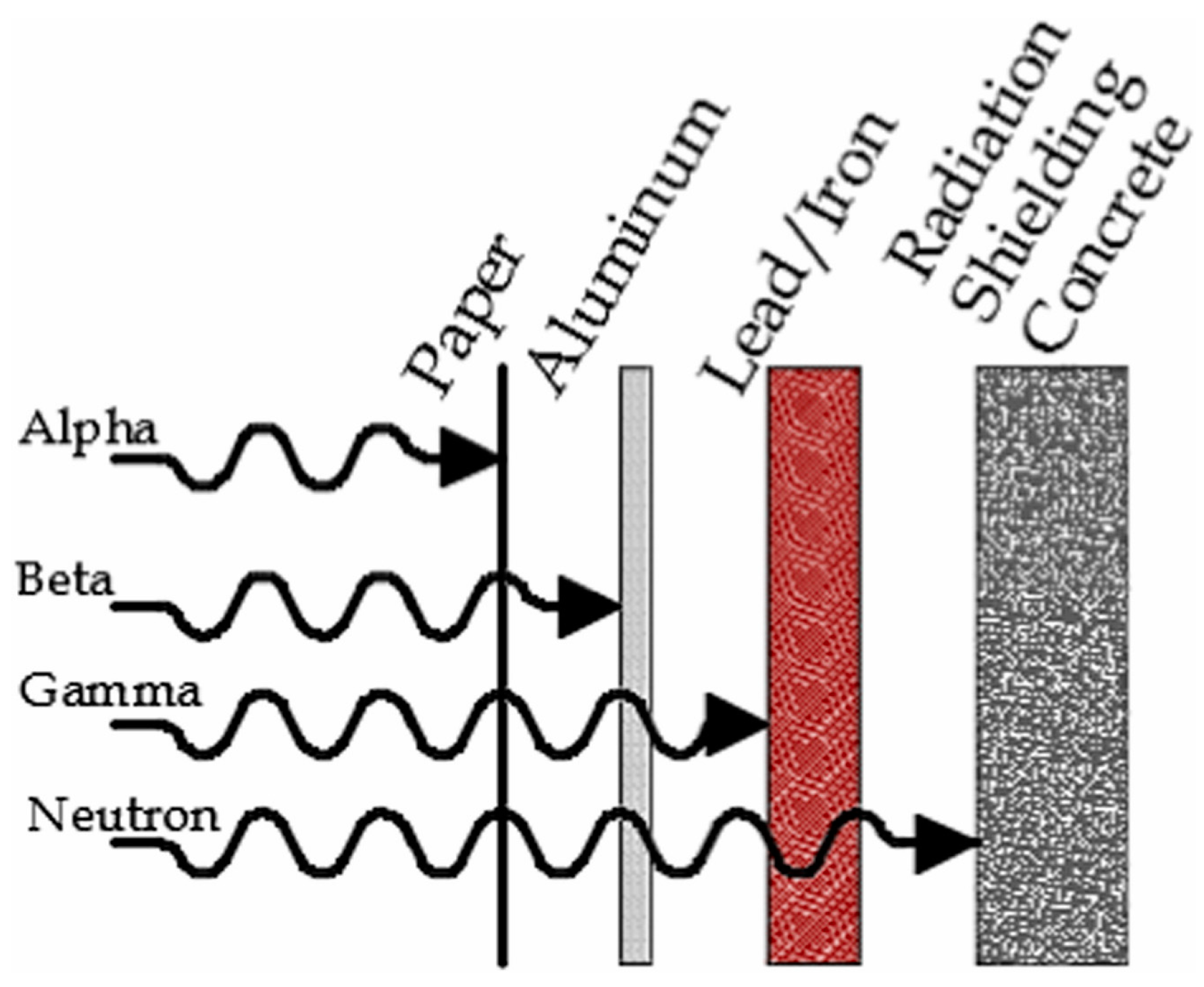
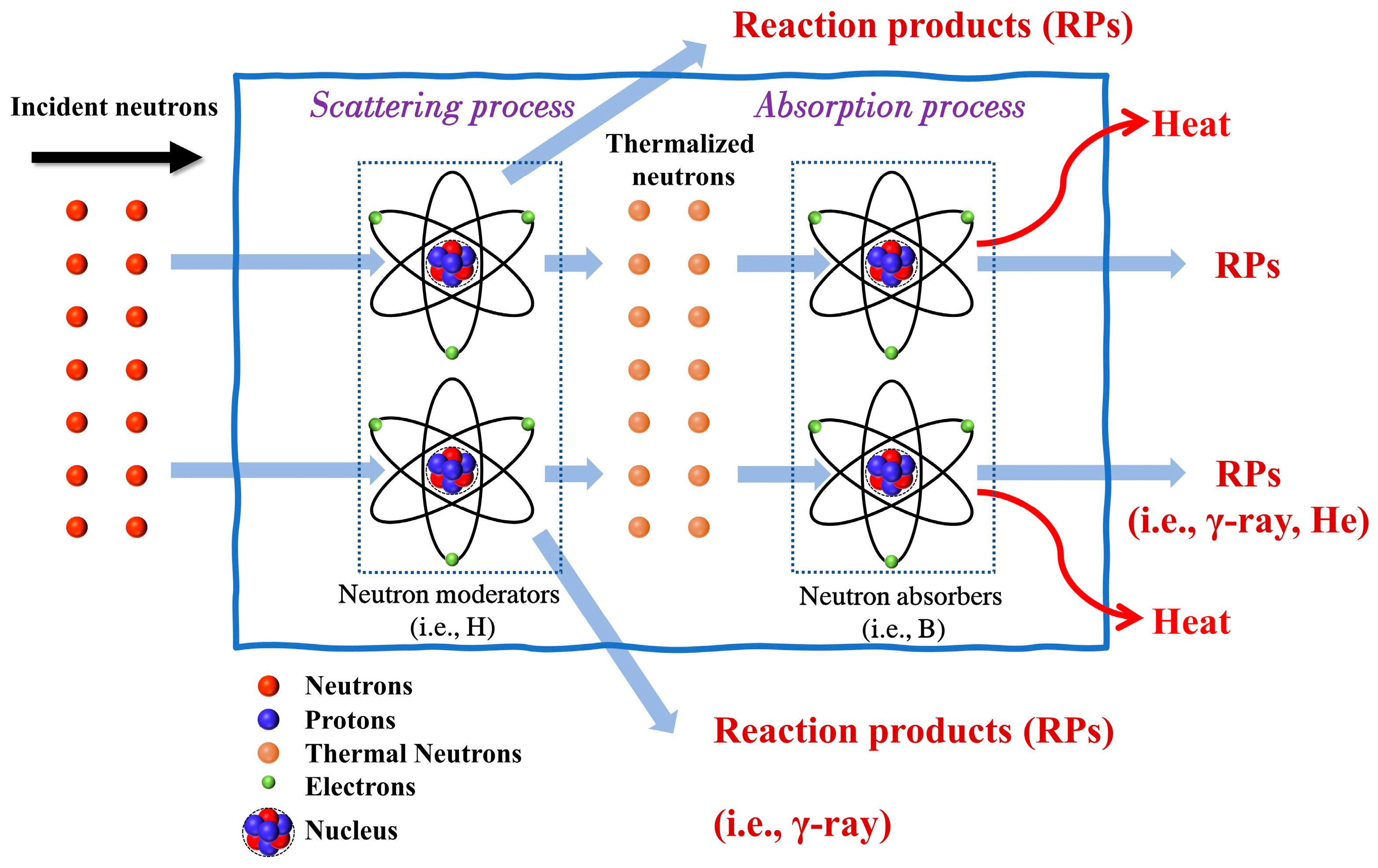
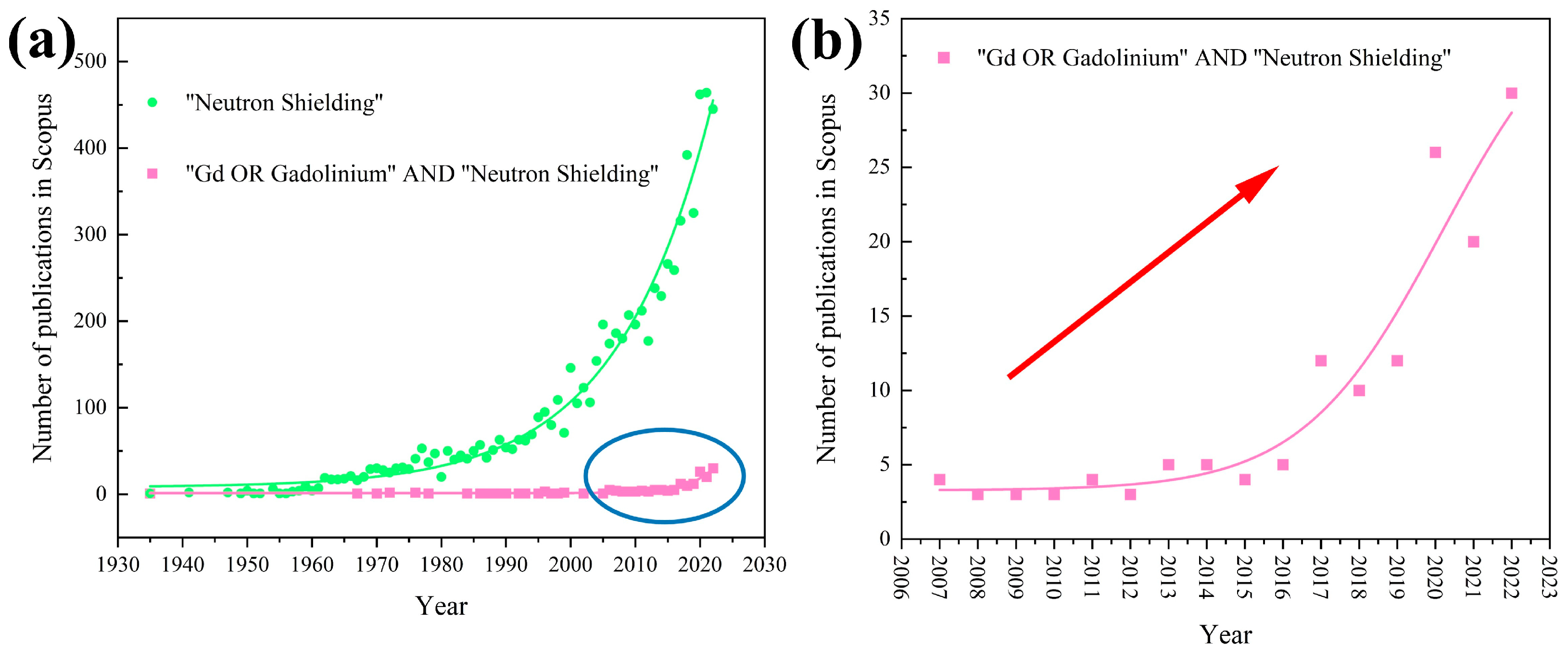

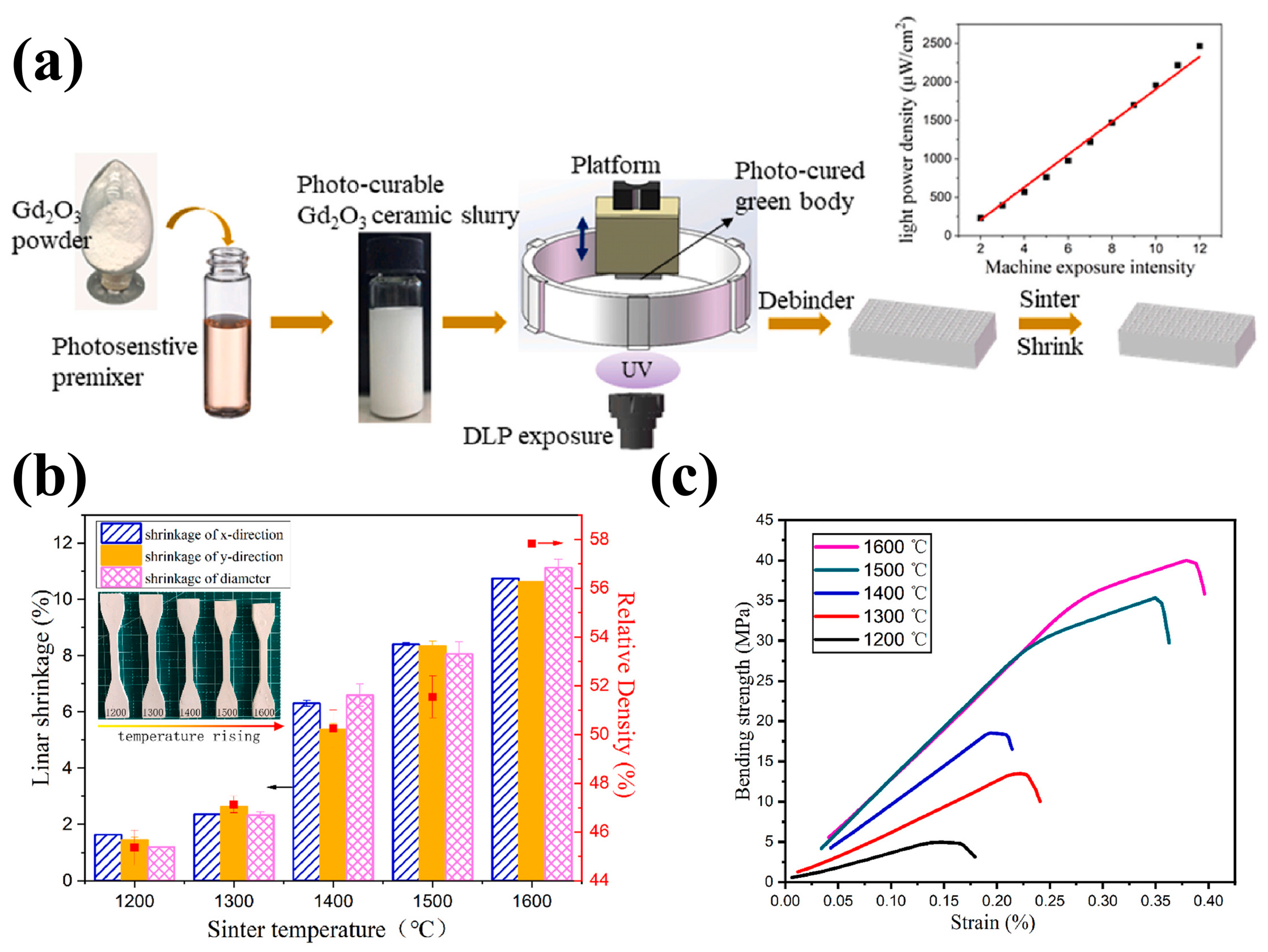
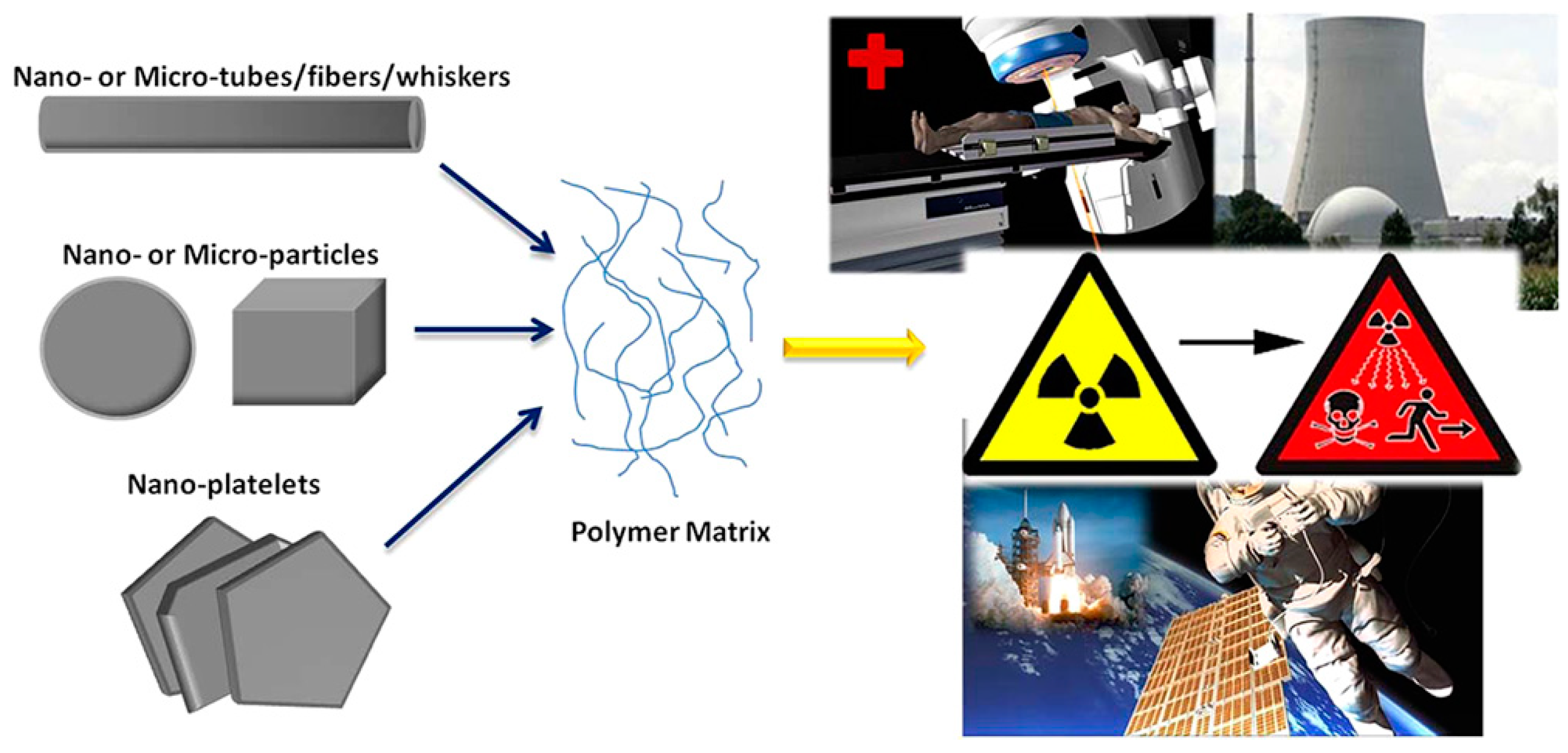
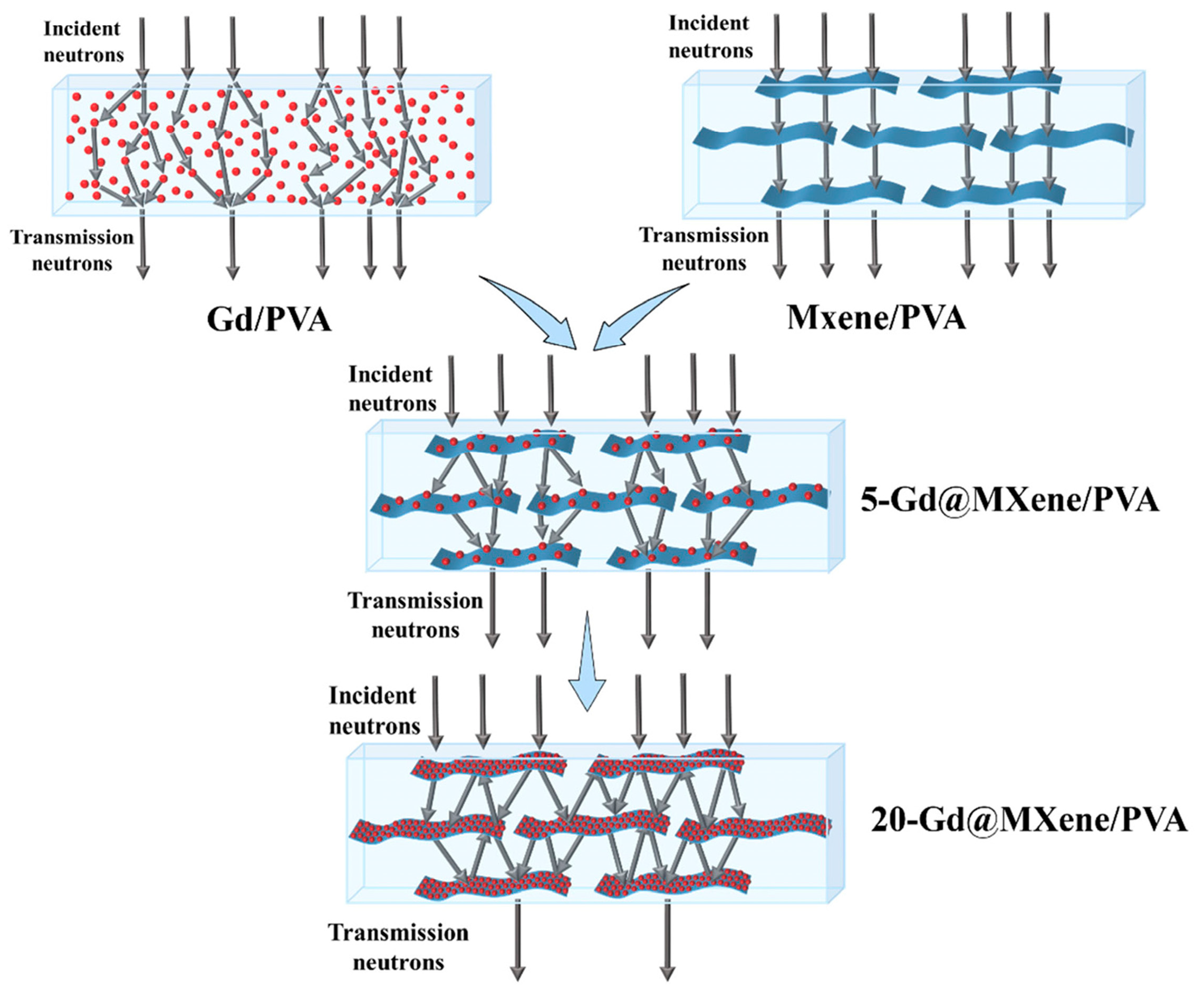
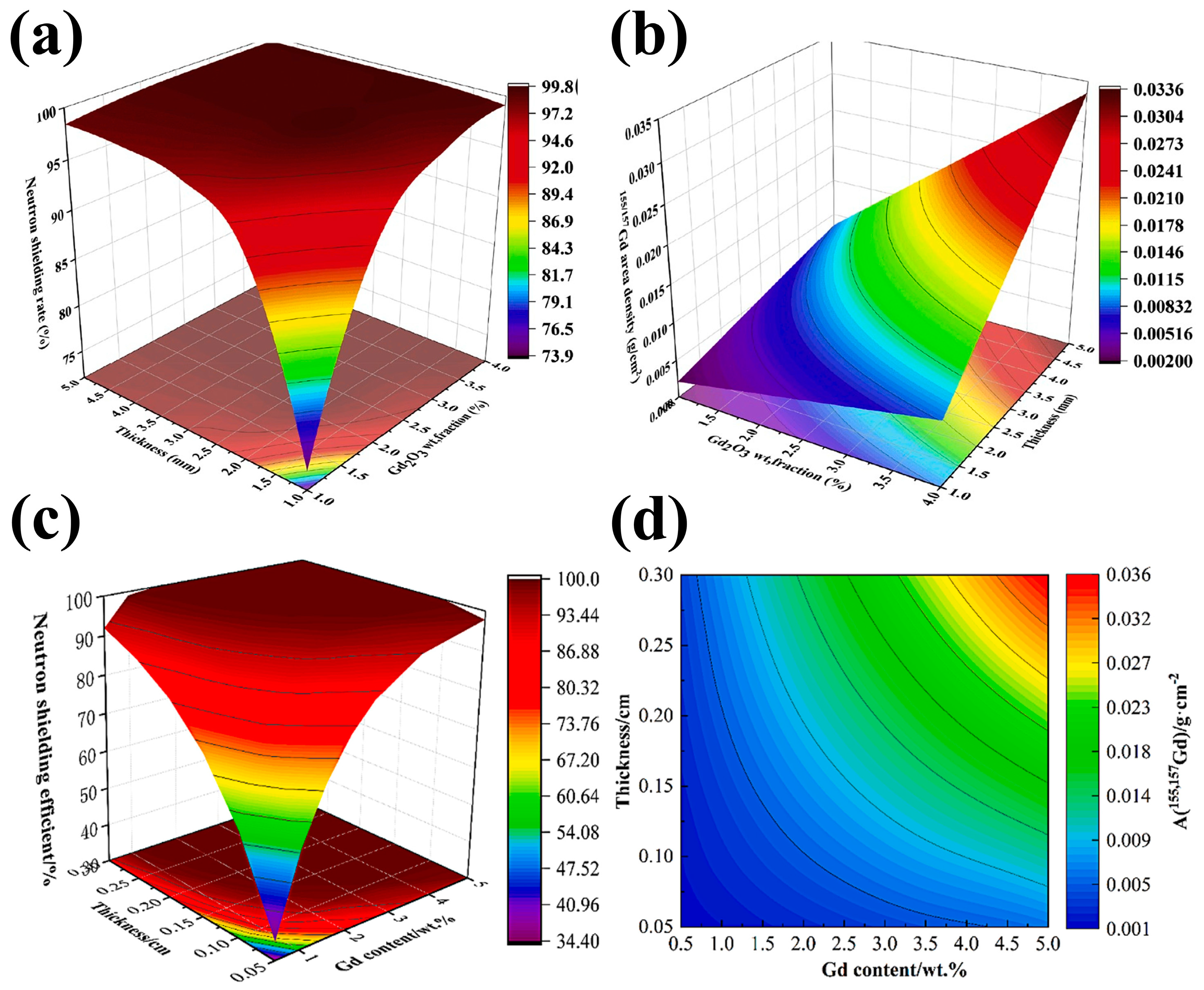
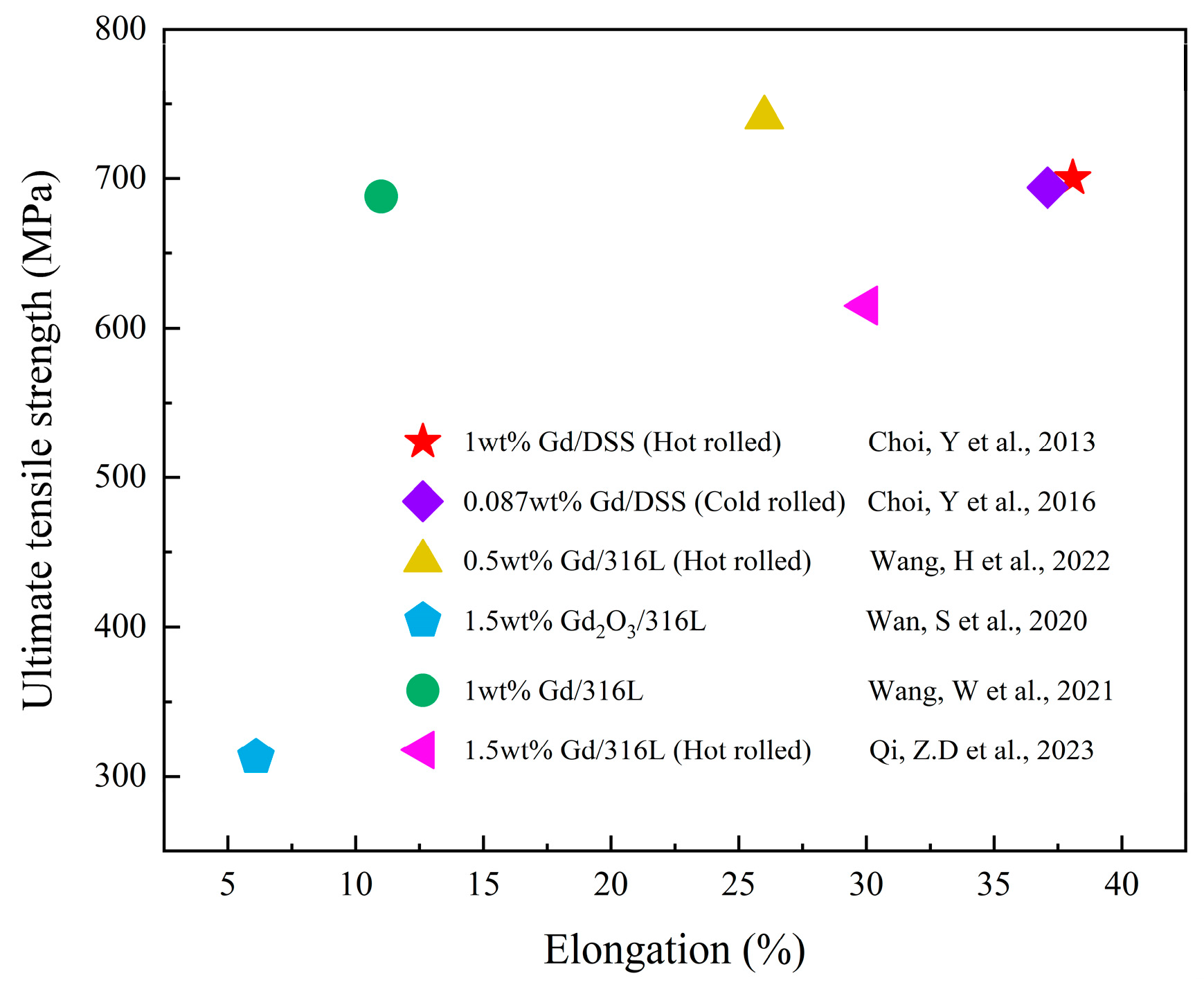
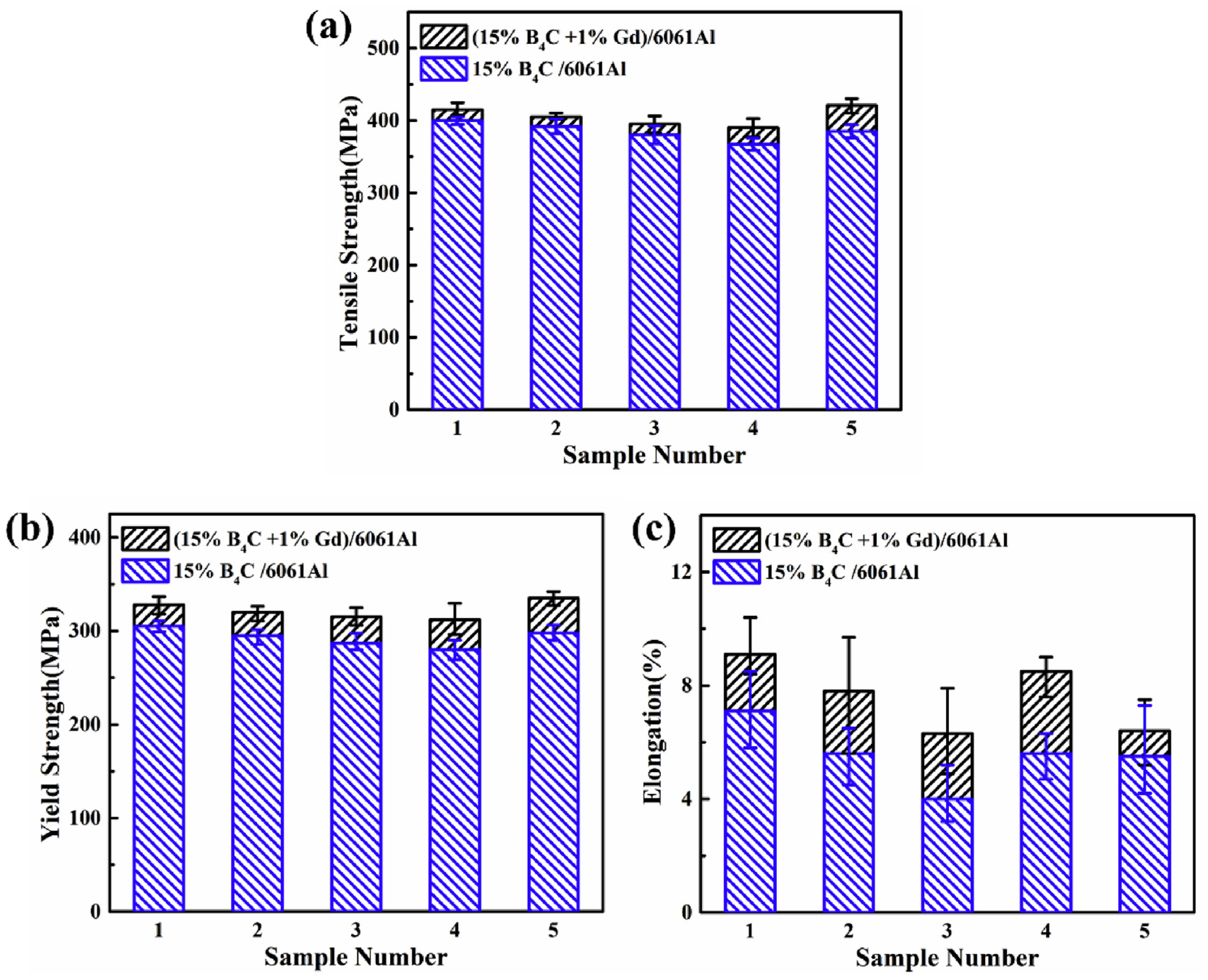


| Element | Corresponding Isotope | Atomic Number | Relative Atomic Mass | Neutron Capture Cross-Sections/Barns | Abundance/wt% |
|---|---|---|---|---|---|
| Boron | 10B | 5 | 10.81 | 3840 | 19.9 |
| Cadmium | 113Cd | 48 | 112.41 | 20,600 | 12.22 |
| Samarium | 149Sm | 62 | 150.36 | 40,000 | 13.8 |
| Gadolinium | 155Gd | 64 | 157.25 | 62,540 | 14.8 |
| 157Gd | 255,000 | 15.65 |
| Year | Matrix | Chemical Composition | Content of Gd-Containing Components | Neutron Shielding Performance * | Main Features | Ref. |
|---|---|---|---|---|---|---|
| 2018 | PMMA | poly(MMA-coGd(MAA)3) | 1.91 wt% | I/I0 = 0.1 (Sample thickness: 5 mm) | Self-polymerization | [70] |
| 2018 | HDPE | h-BN/Gd2O3/HDPE | 3 wt% (with 7 wt%BN) | I/I0 ≈ 0.3 (Sample thickness: 5 cm) | Hybridization of h-BN and Gd2O3 | [82] |
| 2019 | PAN | Gd(MAA)3/PAN | 12.11 wt% | I/I0 = 0.01 (Sample thickness: 2 mm, by simulation) | Self-polymerization | [71] |
| 2019 | EP | Gd-MOF/EP | 10 wt% | I/I0 < 0.1 (Sample thickness: 5 cm, by simulation) | MOF-based | [78] |
| 2020 | PVA | Gd2O3/PVA | 3.5 wt% | I/I0 = 0.43 (Sample thickness: 5 mm, by simulation) | Self-polymerization | [69] |
| 2021 | PI | Gd-MOF/PI | 3 wt% | I/I0 = 0.096 (Sample thickness: 5 cm, for fast neutrons, by simulation) | MOF-based | [79] |
| I/I0 = 0.009 (Sample thickness: 0.2 cm, for thermal neutrons, by simulation) | ||||||
| 2021 | HDPE | Gd2O3/B4C/HDPE | 10 wt% (with 10 wt% B4C and 80 wt% HDPE) | I/I0 = 0.1 (Sample thickness: 9.1 cm) | Surface modification; nanoparticles | [86] |
| 2022 | NR | Gd2O3/NR | 50 phr | I/I0 = 0.55 (Sample thickness: 2 mm) | Self-healing ability | [74] |
| 2022 | PVA | Gd@MXene/PVA | 15.1 wt% | I/I0 = 0.169 (Sample thickness: 1 mm) | MXene-based | [76] |
| 2022 | SAPPS | Gd2O3/SAPPS | 10 wt% | I/I0 = 0.2 (Sample thickness: 2 cm) | Nanoparticles | [85] |
| Year | Matrix | Chemical Composition *,1 | Mechanical Properties | Thermal Neutron Shielding Performance *,2 | Ref. |
|---|---|---|---|---|---|
| 2016 | Pure Al | (1%Gd + 15%B4C)/Al | UTS = 170 MPa, EL ≈ 9% | I/I0 ≈ 0 (sample thickness: 3 mm) | [112] |
| 2017 | Pure Al | (1%Gd + 15%B4C)/Al | UTS = 260 MPa, EL ≈ 7% | Not mentioned | [113] |
| 2019 | 6061Al | (1%Gd + 15%B4C)/6061Al | UTS = 421 MPa, EL ≈ 6.4% | Not mentioned | [114] |
| 2019 | 6061Al | (1%Gd + 15%B4C)/6061Al | UTS = 380 MPa, EL = 5% | I/I0 ≈ 0 (sample thickness: 3 mm) | [115] |
| 2019 | 6061Al | 10%Gd2O3/6061Al | UTS = 240 MPa, EL = 16% | I/I0 = 0.0036 (sample thickness: 10 mm) | [122] |
| 2020 | 6063Al | 25%Gd2O3/Al | Microhardness = 120 HV0.1 | I/I0 ≈ 0 (sample thickness: 0.75 mm) | [124] |
| 2020 | Pure Al | 5%Gd2O3@20%W/Al | UTS = 310 MPa, EL ≈ 3% | I/I0 = 0.01 (sample thickness: 3 mm, by simulation) | [127] |
| 2022 | 6061Al | (10%B4C + 3.6%Gd)/6061Al | UTS = 342 MPa, EL = 2.4% | I/I0 = 0.002 (sample thickness: 3 mm, by simulation) | [118] |
| 2022 | AlMg | 1%Gd/6%TiB2/Al–6%Mg | UTS = 464 MPa, EL = 15.6% | I/I0 ≈ 0 (sample thickness: 8 mm) | [121] |
Disclaimer/Publisher’s Note: The statements, opinions and data contained in all publications are solely those of the individual author(s) and contributor(s) and not of MDPI and/or the editor(s). MDPI and/or the editor(s) disclaim responsibility for any injury to people or property resulting from any ideas, methods, instructions or products referred to in the content. |
© 2023 by the authors. Licensee MDPI, Basel, Switzerland. This article is an open access article distributed under the terms and conditions of the Creative Commons Attribution (CC BY) license (https://creativecommons.org/licenses/by/4.0/).
Share and Cite
Wang, K.; Ma, L.; Yang, C.; Bian, Z.; Zhang, D.; Cui, S.; Wang, M.; Chen, Z.; Li, X. Recent Progress in Gd-Containing Materials for Neutron Shielding Applications: A Review. Materials 2023, 16, 4305. https://doi.org/10.3390/ma16124305
Wang K, Ma L, Yang C, Bian Z, Zhang D, Cui S, Wang M, Chen Z, Li X. Recent Progress in Gd-Containing Materials for Neutron Shielding Applications: A Review. Materials. 2023; 16(12):4305. https://doi.org/10.3390/ma16124305
Chicago/Turabian StyleWang, Kangbao, Litao Ma, Chen Yang, Zeyu Bian, Dongdong Zhang, Shuai Cui, Mingliang Wang, Zhe Chen, and Xianfeng Li. 2023. "Recent Progress in Gd-Containing Materials for Neutron Shielding Applications: A Review" Materials 16, no. 12: 4305. https://doi.org/10.3390/ma16124305
APA StyleWang, K., Ma, L., Yang, C., Bian, Z., Zhang, D., Cui, S., Wang, M., Chen, Z., & Li, X. (2023). Recent Progress in Gd-Containing Materials for Neutron Shielding Applications: A Review. Materials, 16(12), 4305. https://doi.org/10.3390/ma16124305


_Low.png)



